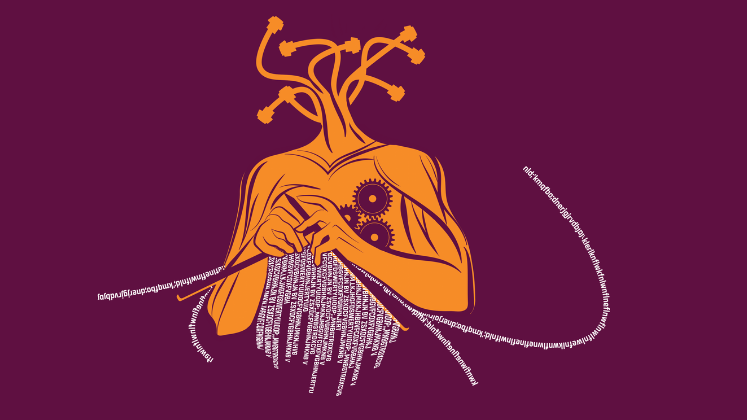Generative AI presents clear implications for teaching and learning in higher education. Drawing on their experience as early adopters of ChatGPT and DALL.E2 for teaching and learning, Bert Verhoeven and Vishal Rana present four ways they can be used to promote creativity and engagement from students.
The emergence of generative AI and the release of ChatGPT has split the realm of higher education. Generative AI in general is often viewed as a cheating tool and a threat to academic integrity. Universities and academics have also shown scepticism about the use of this technology, with some institutions banning it outright. However, whilst a degree of scepticism is warranted, it shouldn’t hold us back from exploring potential positive applications of AI, especially as employers are already beginning to require AI skills in entry level roles.
As part of the Innovation and Enterprise course we run, we were self-conscious early adopters of AI tools such as ChatGPT and DALL.E2 for authentic assessments. In particular, we wanted to explore new uses and applications of this technology, focusing on the design thinking process to find problems and solutions to the United Nations Sustainable Development Goals (UNSDGs). Here, we show how this technology can benefit (1) experiential learning, student engagement, and collaboration; (2) design research and transfer of knowledge skills; (3) creative/critical thinking and reflection skills; and (4) writing and presentation tone and style skills.
Using AI for experiential learning, student engagement and collaboration
One of the ways we use AI in our course is for experiential learning, student engagement, and collaboration. Experiential learning involves learning through reflection on doing and leads to higher student engagement and performance. Authentic assessment as a part of experiential learning requires students to perform real-world tasks to demonstrate meaningful application of essential knowledge and skills, which can include the use of AI tools. Providing students with authentic assessments and specifying what help they are permitted to use for each activity helps prepare them for their professions. In our workshops, we have seen students embrace and engage with ChatGPT and DALL.E2, sharing experiences and prompts with fellow students and expressing surprise and amazement about some of the results.
Using AI for design research and transfer of knowledge skills
Another way we use AI is for design research and the transfer of knowledge skills. For example, students use AI to generate quiz questions for themselves on the content to facilitate revision (self-testing). AI is also used to identify issues, challenges, and questions within the UNSDGs. For example, ChatGPT helped identify the challenges in the Zero Hunger Sustainable Development Goal. After the prompt: ‘What are the challenges in solving hunger as part of the Sustainable Development Goal “Zero Hunger”’, ChatGPT offered a list of challenges, one of which was the following: Food Waste: Approximately one-third of the world’s food is wasted each year. Reducing food waste and promoting food preservation techniques can help ensure that more food is available for those who need it. The students liked this challenge and used the result to further prompt the ChatGPT about challenges in Food Waste. The process of multiple prompting and answers led to a rapid in-depth understanding of the issue, not unlike the root cause analysis 5 whys tool. The students have the option to use another AI tool called the Prompt Box that has the ability to download, back up and share their prompts with anyone.
Image credit: Yasmin Dwiputri & Data Hazards Project, Better Images of AI, AI across industries (CC-BY 4.0)
As teachers, we could notice the depth of research compared to previous years, better preparing current students for empathy interviews (part of the design thinking process) with stakeholders in the field of “food waste” and possibly more sophisticated solutions. As such, AI can be used as a core part of a task, providing many examples related to a topic and allowing students to prompt deeper and test their understanding and identify inaccuracies, gaps, and missing aspects. This approach enhances their transfer of knowledge skills and critical thinking abilities. Students can save time and effort and focus on the more critical aspects of their work, like understanding the user’s needs and wants (a core of the design thinking process).
Using AI for creative/critical thinking and reflection skills
AI can play a role in the facilitation of divergent and convergent thinking processes (part of design thinking). Students use ChatGPT for the generation of ideas. When prompted to generate creative ideas to solve, for instance, homelessness as a part of their UNSDG Goal 11, sustainable cities and communities, ChatGPT came up with 8 ideas ranging from affordable housing, to job training, employment programs and mental health and substance abuse treatment. Students were particularly interested to explore further the idea of Micro-housing (a trend in housing that involves creating small, affordable housing units that are designed for single individuals or couples). AI in the convergent thinking process supports the development, testing (prototype development in DALL.E2 for example) and evaluation of solutions. By combining AI with their own creativity and problem-solving skills, students can generate unique and innovative solutions to complex problems.
Using AI for writing and presentation skills
Finally, students can use AI as a copyediting tool to compare their language and formatting choices with the AI output and make edits to their own work. We encourage students to copy their original work into ChatGPT with the prompt to improve the style and tone of the academic report. Students are then asked to put the original text in the attachment (with reference) and write a reflective paragraph on what they have learned from ChatGPT in terms of tone and style. Non-English native international students, who struggled to express their thoughts in a foreign language, now have a tool to help with clear expression, with a focus on the content. As we teach innovation and not essay writing, this suits our purpose.
Bonus – Using AI to develop an Innovation and Enterprise course?
We have described four ways students use AI as a learning tool in our course. But, it is also helping us as educators to further develop the workshops. When prompted for options for using ChatGPT and DALL.E2 in a university innovation and entrepreneurship course, ChatGPT came up with three more ideas, which we are keen to further explore:
- Business idea brainstorming: Use ChatGPT to generate a list of potential business ideas based on certain criteria, such as market demand, profitability, or social impact. Students can then use DALL.E2 to refine and develop these ideas into viable business models.
- Entrepreneurial case studies: Use ChatGPT to create case studies on successful entrepreneurs and startups. Students can use these case studies to learn from real-world examples and identify key strategies and best practices that can be applied to their own entrepreneurial ventures.
- Business pitch practice: Use DALL.E2 to create a virtual pitch practice platform for students to develop their pitching skills. Students can receive feedback on their delivery, content, and presentation skills, and iterate on their pitches until they are polished and effective.
Importance of Transparency and Formal Acknowledgment
The use of AI and ChatGPT in academic courses can significantly enhance student learning outcomes by improving the transfer of knowledge skills, critical thinking and reflection skills, and self-testing capabilities. By adopting AI as a core part of their tasks, students can harness the power of this technology to generate unique and innovative solutions to complex problems. However, it is important to be transparent and formally acknowledge the use of AI, ensuring that students are aware of the role it plays in their work.
The content generated on this blog is for information purposes only. This Article gives the views and opinions of the authors and does not reflect the views and opinions of the Impact of Social Science blog (the blog), nor of the London School of Economics and Political Science. Please review our comments policy if you have any concerns on posting a comment below.
Image credit: Yasmin Dwiputri & Data Hazards Project, Better Images of AI, AI across industries (CC-BY 4.0)









Can you unpack the feedback process? Which part of DELL.E2 can be used to provide feedback for student presentations?